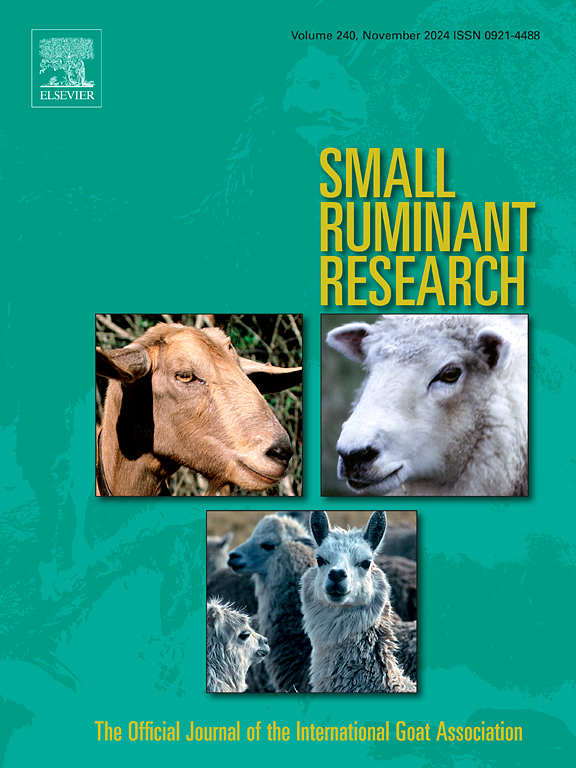Income over loss: How management systems lower mortality and increase farm incomes from small ruminants in urbanizing Africa
IF 1.4
3区 农林科学
Q2 AGRICULTURE, DAIRY & ANIMAL SCIENCE
引用次数: 0
Abstract
Small ruminant (sheep and goat) production is often promoted as low-labor and low-investment, yet empirical evidence on how management systems affect performance in urban and peri-urban contexts remains limited. This study investigates the determinants of management system choice among livestock farmers and evaluates the causal effects of these systems on mortality rates and farm income. Using data from 400 randomly sampled farmers in Ejisu and Juaben (Ashanti region, Ghana) during April–May 2024, we employed a multinomial logit model to analyze system adoption drivers. A multinomial treatment effect model further isolated the causal impacts of management systems on outcomes. Results indicate that 50.5 % of farmers use free-range systems, 30 % semi-intensive, and 20 % intensive systems. Key determinants for adopting semi-intensive or intensive systems over free-range include: gender, education, herd size, extension service access, primary occupation, religious affiliation, marital status, engagement in non-farm businesses, and market proximity. Critically, semi-intensive and intensive systems significantly reduced mortality rates and increased farm income compared to free-range systems. These findings demonstrate that targeted investments in livestock infrastructure (e.g., housing), veterinary services, extension support, and technical training can enhance productivity and economic returns for smallholders. To ensure sustainable urban small ruminant production, policies must be context-specific, accounting for the distinct requirements of each management system. Additionally, the extensive or free-range systems could be improved by adopting animal tethering on communal lands to reduce mortality rates.
收益大于损失:管理系统如何在非洲城市化进程中降低小反刍动物的死亡率并增加农场收入
小型反刍动物(绵羊和山羊)的生产通常被宣传为低劳动力和低投资,但关于管理制度如何影响城市和城郊环境下的绩效的经验证据仍然有限。本研究探讨畜禽养殖户管理制度选择的决定因素,并评估这些制度对死亡率和农场收入的因果影响。利用2024年4 - 5月在加纳阿散蒂地区埃吉苏和Juaben随机抽样的400名农民的数据,采用多项逻辑模型分析了系统采用的驱动因素。多项治疗效果模型进一步隔离了管理系统对结果的因果影响。结果表明,50.5% %的农户采用散养方式,30% %采用半集约化方式,20% %采用集约化方式。采用半集约化或集约化系统而非散养系统的关键决定因素包括:性别、教育程度、畜群规模、推广服务的可及性、主要职业、宗教信仰、婚姻状况、从事非农业企业以及市场邻近程度。关键的是,与散养系统相比,半集约化和集约化系统显著降低了死亡率并增加了农场收入。这些发现表明,对牲畜基础设施(如住房)、兽医服务、推广支持和技术培训进行有针对性的投资可以提高小农的生产力和经济回报。为了确保可持续的城市小反刍动物生产,政策必须因地制宜,考虑到每个管理系统的不同要求。此外,可以通过在公共土地上采用动物拴系来改善粗放型或自由放养系统,以降低死亡率。
本文章由计算机程序翻译,如有差异,请以英文原文为准。
求助全文
约1分钟内获得全文
求助全文
来源期刊

Small Ruminant Research
农林科学-奶制品与动物科学
CiteScore
3.10
自引率
11.10%
发文量
210
审稿时长
12.5 weeks
期刊介绍:
Small Ruminant Research publishes original, basic and applied research articles, technical notes, and review articles on research relating to goats, sheep, deer, the New World camelids llama, alpaca, vicuna and guanaco, and the Old World camels.
Topics covered include nutrition, physiology, anatomy, genetics, microbiology, ethology, product technology, socio-economics, management, sustainability and environment, veterinary medicine and husbandry engineering.
 求助内容:
求助内容: 应助结果提醒方式:
应助结果提醒方式:


